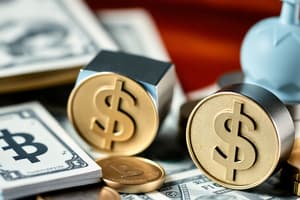Podcast
Questions and Answers
What is the main focus of reading 15.1 - 15.3 on Options?
What is the main focus of reading 15.1 - 15.3 on Options?
- Analyzing the factors affecting the shape of the yield curve for options
- Understanding the terminology and payoff diagrams of options (correct)
- Calculating the impact of interest rate projections on option prices
- Explaining the general terms of an options contract
Which learning objective discusses the computation of a bond’s price given its yield to maturity?
Which learning objective discusses the computation of a bond’s price given its yield to maturity?
- LO 10-7
- LO 10-5
- LO 10-3
- LO 10-2 (correct)
What does Learning Objective 10-4 focus on?
What does Learning Objective 10-4 focus on?
- Calculating several measures of bond return
- Describing call, convertibility, and sinking fund provisions in bonds (correct)
- Analyzing the factors affecting the shape of the yield curve
- Identifying the determinants of bond safety and rating
What is the main topic of reading 12.6 on Business Cycles?
What is the main topic of reading 12.6 on Business Cycles?
Which type of bonds offer lower coupon rates and yields to maturity, but their actual returns may exceed the stated yield if the option to convert becomes profitable?
Which type of bonds offer lower coupon rates and yields to maturity, but their actual returns may exceed the stated yield if the option to convert becomes profitable?
What feature do some corporate bonds have that allows the issuer to repurchase the bond at a specified call price before maturity?
What feature do some corporate bonds have that allows the issuer to repurchase the bond at a specified call price before maturity?
What do safer bonds with higher ratings offer in terms of yields to maturity?
What do safer bonds with higher ratings offer in terms of yields to maturity?
What do puttable bonds give the bondholder the option to do?
What do puttable bonds give the bondholder the option to do?
What is the basis for accrued interest on a bond?
What is the basis for accrued interest on a bond?
How are bond prices quoted?
How are bond prices quoted?
Where do corporate bonds trade?
Where do corporate bonds trade?
What contributes to the thinness of the bond market?
What contributes to the thinness of the bond market?
What information is included in corporate bond listings?
What information is included in corporate bond listings?
What do some corporate bonds come with that allows the issuer to repurchase the bond at a specified call price before maturity?
What do some corporate bonds come with that allows the issuer to repurchase the bond at a specified call price before maturity?
What do convertible bonds give bondholders the option to exchange the bond for?
What do convertible bonds give bondholders the option to exchange the bond for?
What does the sale price of a bond include?
What does the sale price of a bond include?
What type of bonds depend on specific events like earthquakes or pandemics?
What type of bonds depend on specific events like earthquakes or pandemics?
Which type of bonds offer higher coupon rates to compensate for the risk of losing part or all of the investment in a catastrophe?
Which type of bonds offer higher coupon rates to compensate for the risk of losing part or all of the investment in a catastrophe?
Which bonds make payments tied to a general price index or commodity prices?
Which bonds make payments tied to a general price index or commodity prices?
How are TIPS bond cash flows calculated based on inflation rates?
How are TIPS bond cash flows calculated based on inflation rates?
What was the real yield on TIPS bonds for a 30-year maturity in early 2020?
What was the real yield on TIPS bonds for a 30-year maturity in early 2020?
What influences the present value of future cash flows for bond pricing?
What influences the present value of future cash flows for bond pricing?
What happens to the present value of each dollar of cash flow from a bond as market interest rates rise?
What happens to the present value of each dollar of cash flow from a bond as market interest rates rise?
What are the additional premiums for bond-specific characteristics that influence bond pricing?
What are the additional premiums for bond-specific characteristics that influence bond pricing?
What is used to discount future cash flows for bond pricing?
What is used to discount future cash flows for bond pricing?
What may benefit from a single interest rate for discounting cash flows?
What may benefit from a single interest rate for discounting cash flows?
What are debt securities also known as?
What are debt securities also known as?
Why are debt securities, such as bonds, relatively easy to understand?
Why are debt securities, such as bonds, relatively easy to understand?
What is the bond indenture?
What is the bond indenture?
How are zero-coupon bonds different from regular bonds?
How are zero-coupon bonds different from regular bonds?
What are Treasury notes?
What are Treasury notes?
How are bond prices quoted?
How are bond prices quoted?
What does the yield to maturity measure?
What does the yield to maturity measure?
What is the difference between Treasury notes and Treasury bonds?
What is the difference between Treasury notes and Treasury bonds?
How are zero-coupon bonds issued?
How are zero-coupon bonds issued?
What determines the investor's return from zero-coupon bonds?
What determines the investor's return from zero-coupon bonds?
How are bond prices quoted in the market?
How are bond prices quoted in the market?
What must a buyer pay if a bond is purchased between coupon payments?
What must a buyer pay if a bond is purchased between coupon payments?
Which type of bond has a dividend rate linked to current market interest rates and is adjusted at regular intervals?
Which type of bond has a dividend rate linked to current market interest rates and is adjusted at regular intervals?
What do foreign bonds denominated in the currency of the country in which they are marketed include?
What do foreign bonds denominated in the currency of the country in which they are marketed include?
What do international bonds denominated in one currency but sold in other national markets include?
What do international bonds denominated in one currency but sold in other national markets include?
What are innovative bonds with unusual features, such as bonds with maturities ranging from 50 to 100 years and inverse floaters, examples of?
What are innovative bonds with unusual features, such as bonds with maturities ranging from 50 to 100 years and inverse floaters, examples of?
What did the British government issue in the 18th century with infinite maturity, making them perpetuities?
What did the British government issue in the 18th century with infinite maturity, making them perpetuities?
What do municipal bonds issued by state and local governments have?
What do municipal bonds issued by state and local governments have?
What do floating-rate bonds have coupon rates that reset periodically according to?
What do floating-rate bonds have coupon rates that reset periodically according to?
What do preferred stock dividends offer a tax advantage to?
What do preferred stock dividends offer a tax advantage to?
What are Eurobonds denominated in and sold in other national markets?
What are Eurobonds denominated in and sold in other national markets?
What are floating-rate preferred stock dividends linked to?
What are floating-rate preferred stock dividends linked to?
What do failure to pay dividends on preferred stock result in?
What do failure to pay dividends on preferred stock result in?
What do innovative bond designs illustrate about bond structures?
What do innovative bond designs illustrate about bond structures?
Study Notes
Bond Characteristics and Valuation Principles
- Debt securities are also known as fixed-income securities and promise either a fixed stream of income or income determined by a specified formula.
- Debt securities, such as bonds, are relatively easy to understand due to their specified payment formulas and minimal uncertainty about cash flows.
- The bond is the basic debt security, and the chapter provides an overview of bond markets, including Treasury, corporate, and international bonds.
- The coupon rate, maturity date, and par value of the bond are part of the bond indenture, which is the contract between the issuer and the bondholder.
- Bonds are usually issued with coupon rates set just high enough to induce investors to pay par value to buy the bond.
- Zero-coupon bonds make no coupon payments and are issued at prices considerably below par value, with the investor's return coming solely from the difference between issue price and the payment of par value at maturity.
- Treasury notes are issued with original maturities between 1 and 10 years, while Treasury bonds are issued with maturities ranging from 10 to 30 years.
- The prices of bonds are quoted as a percentage of par value, and the yield to maturity is often interpreted as a measure of the average rate of return to an investor who purchases the bond for the asked price and holds it until its maturity date.
- The quoted bond prices do not include the interest that accrues between coupon payment dates, and if a bond is purchased between coupon payments, the buyer must pay the seller for accrued interest, the prorated share of the upcoming semiannual coupon.
Bonds and Preferred Stock Overview
- Floating-rate bonds have coupon rates that reset periodically according to a specified market rate, subject to credit risk and price fluctuations.
- Preferred stock, though considered equity, promises a specified cash flow stream similar to bonds, but failure to pay dividends results in cumulative owed dividends.
- Floating-rate preferred stock, like floating-rate bonds, has a dividend rate linked to current market interest rates and is adjusted at regular intervals.
- Preferred stock dividends are not tax-deductible expenses, reducing their attractiveness as a source of capital to issuing firms, but they offer a tax advantage to corporations.
- Municipal bonds issued by state and local governments have tax-free interest payments.
- International bonds include foreign bonds, denominated in the currency of the country in which they are marketed, and Eurobonds, denominated in one currency but sold in other national markets.
- Foreign bonds sold in the U.S. are called Yankee bonds, while Eurobonds fall outside U.S. jurisdiction and are not regulated by U.S. federal agencies.
- Issuers constantly develop innovative bonds with unusual features, such as bonds with maturities ranging from 50 to 100 years and inverse floaters, where the coupon rate falls when interest rates rise.
- The British government issued consols in the 18th century with infinite maturity, making them perpetuities.
- Innovative bond designs illustrate the flexibility of bond structures and the potential variety in security design.
Studying That Suits You
Use AI to generate personalized quizzes and flashcards to suit your learning preferences.
Related Documents
Description
Test your knowledge of bond characteristics and valuation principles with this quiz. Explore topics such as debt securities, bond indenture, coupon rates, Treasury bonds, yield to maturity, and innovative bond designs. Additionally, learn about preferred stock, municipal bonds, and international bonds, including Eurobonds and Yankee bonds.




